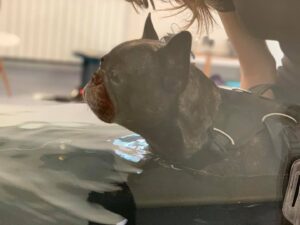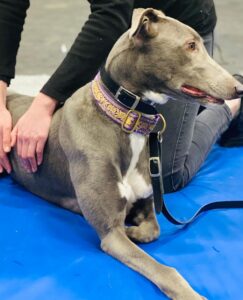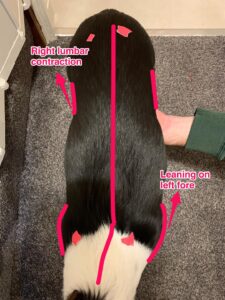So you have had your dog for a while…they suddenly get a limp or start moving oddly…you go to the vet and find out they have ruptured their cruciate ligament, or they have intervertebral disc disease…and you find out this is “common” for your dogs breed…and you wonder why you didn’t know about this before….
Sound familiar??? Well hopefully this latest blog post will help…so share far and wide for all dog owners and potential dog owners to know!
Common Musculoskeletal Conditions and The Commonly Affected Breeds

Hip Dysplasia – Labrador Retriever, Golden Retriever, German Shepherd, Rottweiler, Bernese Mountain Dog, Newfoundland (King, 2017; James et al. 2020), Belgian Malinois, Irish Setter (Comhaire, 2014), Bulldog, Neapolitan Mastiff (King, 2017), Rhodesian Ridgeback (Lewis et al. 2013), Bloodhound, Old English Sheepdog, Bullmastiff, Chow Chow, Corgi, Staffordshire Terrier (Orberhauer et al. 2017), German Shorthair Pointer, Springer Spaniel (Valliant and Fagan, 2014)
Elbow Dysplasia – Labrador Retriever, Golden Retriever, German Shepherd, Rottweiler, Bernese Mountain Dog, Newfoundland (James et al. 2020), Rhodesian Ridgeback (Lewis et al. 2013),
Intervertebral Disc Disease (IVDD) – Dachshund, Doberman Pinscher, Labrador Retriever (Valliant and Fagan, 2014), Beagle, Corgi, French Bulldog, Basset Hound, Pekingese (Fenn et al. 2020)
Luxating Patella – Poodle, Pomeranian, Yorkshire Terrier, Chihuahua, French Bulldog, Lhasa Apso, Cavalier King Charles Spaniel, Bichon Frise, Pug, Bulldog, West Highland Terrier, Jack Russell Terrier, Shit-tzu (Di Dona et al. 2018), Staffordshire Bull Terrier (Boge et al. 2019)
Cranial Cruciate Ligament Rupture – Rottweiler (Necas et al. 2000; Boge et al. 2019), Staffordshire Terrier, Cocker Spaniel, Chow Chow, German Shorthair Pointer (Necas et al. 2000); Labrador Retriever, Beagle, Boxer, Bulldog, Maltese, Bullmastiff, Doberman Pinscher (Pecin et al. 2017)
Chronic Degenerative Myelopathy (CDM/DM) – German Shepherd (Valliant and Fagan, 2014), Corgi, Bernese Mountain Dog, Boxer, Pit-bull Terrier (Zeng et al. 2014), Labrador Retriever, Rhodesian Ridgeback, Poodle, Siberian Husky, any many more with recent diagnostic advances….(Coates, et al. 2004)
Cervical vertebral stenosis/malformation (Wobblers) – Doberman Pinscher, Great Dane, Basset Hounds (Valliant and Fagan, 2014)
Specific Issues in Specific Breeds

In addition to the conditions and breeds above, there are some breeds with some very specific conditions common for them:
Springer/Cocker Spaniels suffer from incomplete ossification of the humeral condyle and therefore lead to humeral fractures (Moores et al. 2012)
Collies obtain carpal hyperextension due to degenerative ligament disease and sporting purposes (Matiasovic and Bush, 2016)
Chondystrophic (short-legged) dogs and IVDD (Fenn et al. 2020). Medium-large breed dogs and hip/elbow dysplasia are very common as noted above, and dogs with conformationally upright limbs link to patella luxation (Di Dona et al. 2018).
Common Sporting Injuries

Agility – shoulder muscular injuries such as biceps brachii tenosynovitis, medial shoulder instability, and carpal injuries (Baltzer, 2012), and iliopsoas strain (Markley et al. 2021)
Flyball – chronic ligament laxity and achilles/calcaneal tendon rupture (Baltzer, 2012)
Racing Greyhounds – general muscle tears alongside metacarpal and metatarsal fractures (Knight, 2018)
Gundog and Canicross dogs tend to receive injuries as associated with the breed as-well-as general abrasion and foot injuries.
What Do I Do With This Info?!
As much as this guide is aimed to educate and guide, it should be noted just because you have a breed mentioned, does not mean they will definitely get that pathology, or that they definitely will not get one of the others listed. And it also does not mean if your dogs breed is not listed they will not get any of the above conditions. BUT prevention is better than cure as they say, and prehab is better than rehab, so by being aware of your dogs “flaws”, can help you be aware, monitor, and put steps in place to prevent them developing. Different management practices can be put in place like not allowing up and down the stairs and raising feed-bowls, feed supplements to try for support, and exercises to do to strengthen them to prevent any problems, such as sit to stand exercises, giving paw, and slow lead walking. Having good insurance also covering the costs of the common conditions for your dog breed will also massively help you should the worst happen. Most insurers nowadays cover physio and hydrotherapy also!
Physio is excellent as a pre-hab and rehab, and improves recovery outcomes for many of these conditions, including reducing pain levels aswell-as overall recovery, and in some cases increasing life length and preventing the need for surgery, but that is a whole other blog post for each condition! But some examples….Physiotherapy can improve surgical outcomes for TPLOs following canine cruciate ligament rupture (Marcellin-Little and Arnoldy, 2018), and following IVDD surgery (Hady and Shwarz, 2015), aswell-as improving longevity of life following DM diagnosis (Zeng et al. 2014)

Additionally, screening your new dog for such conditions can help where possible, for example choosing sires and dams with proven good hip and elbow scores can prevent such issues (James et al. 2020), or asking re conditions in their breed line. And once you have your puppy, restricting access to stairs and hard floors, and preventing excessive exercise when young can ensure their young joints aren’t overworked! Breeds with genetic predispositions need to be monitored throughout their life for signs of pathology, and preventing unnecessary dangers like ball throwing can help them have a longer happier life.
And finally, if you have a sporting dog…performing a good warm up to prevent issues, such as agility dogs need slow lead walking prior to their intense exercise, and home exercises to shift their weight to their hindlimbs to protect their shoulders, as well as stretches to prevent shoulder musculature tension (as shown and advised by a physio). And flyball dogs benefit from carpal supports!
So get in touch if you would like to discuss pre-hab for your dog, or rehab if your dog has already suffered from one of the mentioned conditions! Or if you have a breed/condition not mentioned and would like me to look in to it and provide you with some information! And if you are worried about your dog, please do contact a vet to discuss your concerns.
References:
Baltzer, 2012. Sporting dog injuries. Veterinary Medicine. https://picardy-sheepdog.com/wp-content/uploads/2017/05/vetm0412_SportInjuries.pdf
Boge et al. 2019. Breed susceptibility for common surgically treated orthopaedic diseases in 12 dog breeds. Acta Veterinaria Scandinavica. 61(19). https://actavetscand.biomedcentral.com/articles/10.1186/s13028-019-0454-4
Coates et al. 2004. Canine Degenerative Myelopathy. BSAVA. http://www.delawarevalleyacademyvm.org/pdfs/oct10/CanineDegenMyelopathy.pdf
Comhaire, 2014. The Relation between Canine Hip Dysplasia, Genetic Diversity and Inbreeding by Breed. Open Journal of Veterinary Medicine. http://www.scirp.org/journal/PaperInformation.aspx?PaperID=45804
Di Dona et al. 2018. Patella Luxation in Dogs. Veterinary Medicine (Auckland). 9. https://dx.doi.org/10.2147%2FVMRR.S142545
Fenn et al. 2020. Classification of Intervertebral Disc Disease. Frontiers in Veterinary Science. https://doi.org/10.3389/fvets.2020.579025
James et al. 2020. Effectiveness of Canine Hip and Elbow Dysplasia Improvement Programs in Six UK Pedigree Breeds. Frontiers in Veterinary Science. https://doi.org/10.3389/fvets.2019.00490
King, 2017. Etiopathogenesis of Canine Hip Dysplasia, Prevalence, and Genetics. Veterinary Clinics of North America: Small Animal Practice. 47(4). https://doi.org/10.1016/j.cvsm.2017.03.001
Knight, 2018. Injuries in racing greyhounds. WBI Studies Repository. https://www.wellbeingintlstudiesrepository.org/cgi/viewcontent.cgi?article=1004&context=comarac
Lewis et al. 2013. Comparative analyses of genetic trends and prospects for selection against hip and elbow dysplasia in 15 UK dog breeds. BMC Genomic Data. 14(16). https://bmcgenomdata.biomedcentral.com/articles/10.1186/1471-2156-14-16
Markley et al. 2021. Internet-based survey of the frequency and types of orthopedic conditions and injuries experienced by dogs competing in agility. American Veterinary Medicine Association. 259(9). https://doi.org/10.2460/javma.259.9.1001
Matiasovic and Bush, 2016. Carpal hyperextension injuries. Vet Times. https://www.vettimes.co.uk/app/uploads/wp-post-to-pdf-enhanced-cache/1/carpal-hyperextension-injuries.pdf
Moores et al. 2012. Prevalence of incomplete ossification of the humeral condyle and other abnormalities of the elbow in English Springer Spaniels. Vet Comp Orthop Traumatol. 3. https://www.orthovetsupersite.org/sites/default/files/vcot-full-paper/vcot_2012_25_3_17204.pdf
Necas et al. 2000. Predisposition of dog breeds to cranial cruciate ligament rupture. Acta Vet BRNO. 69. https://pdfs.semanticscholar.org
Pecin et al. 2017 Breed, gender, age and reproductive status in relation to the predisposition for cranial cruciate ligament rupture in 117 dogs treated by a single surgeon (2010 – 2015) – a short communication. Veterinarski Arhiv. 87(6). doi: 10.24099/vet.arhiv.160412
Orberhauer et al. 2017. Long-term genetic selection reduced prevalence of hip and elbow dysplasia in 60 dog breeds. PLOS ONE. https://doi.org/10.1371/journal.pone.0172918
Valliant and Fagan 2014. Healthcare Costs Associated with Specific Dog Breeds. Rutgers University Library. https://doi.org/doi:10.7282/T3SX6G5V
Zeng et al. 2014. Breed Distribution of SOD1 Alleles Previously Associated with Canine Degenerative Myelopathy. Journal of Veterinary Internal Medicine. 28. https://onlinelibrary.wiley.com/doi/pdfdirect/10.1111/jvim.12317

